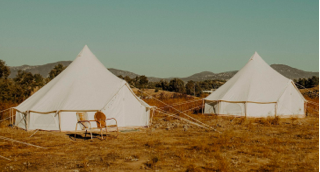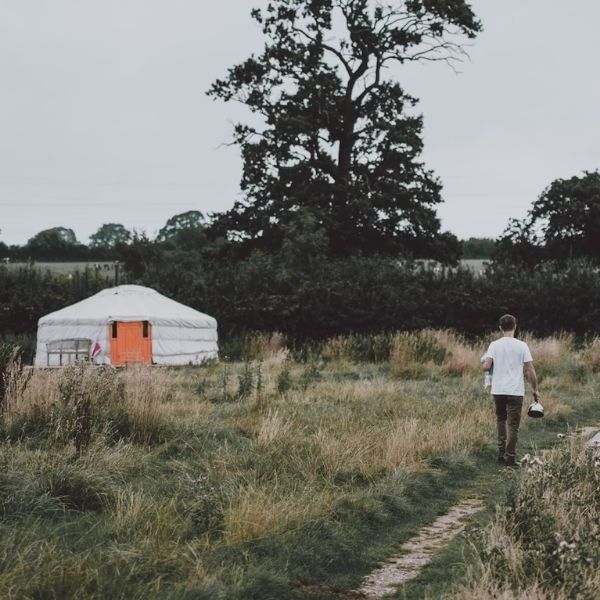PAY NO SALES TAX
Questions? CALL 971-220-8368
Free Shipping

Pay No Sales Tax
30-Month Warranty
PAY NO SALES TAX
Questions? CALL 971-220-8368
Tents
Shop


The LiT List
Glamping & Camping Ideas + Resources
Preventing Condensation in a Camping Tent
4 min read
Did you know a single camper produces nearly one pint of condensation inside a tent? Spare your cabin camping tents from condensation, along with mold, mildew, and, well… just a damp and uncomfortable camping experience.
Use these condensation prevention tips and manage condensation in your camping tent.
How Tent Condensation is Created
Condensation occurs when warm air contacts cold surfaces, causing water vapor to turn into small droplets of water. So when the night turns chilly outside, as the family is all snug and warm inside a tent, condensation can and will occur. A tent’s rainfly keeps out the pitter-patter of rain, but condensation from inside can still gather on the underside, dripping through the mesh materials.
And although thicker canvas tents provide that much of an extra layer, from time to time, condensation will happen if you are not careful. Rainier conditions and colder nights are notorious for creating condensation, even in the hardiest of tents.
So let’s take a look at what you can do to manage condensation inside a tent and keep you dry.
8 Ways to Prevent Condensation in Your Tent

Preventing condensation buildup inside a tent really comes down to managing its air circulation. Here are some tips and tricks to remember to keep those raindrops away and maintain your tent.
1. Set Up on a Dry Site With Protective Trees
Trees are wonderful at providing shade, but they also ensure a blanket of warm air beneath the branches. While this might seem contradictory in preventing condensation in your tent, it ensures the top of your tent (or rainfly) is warmer too, which means the condensation transfers to the branches and not the tent.
2. Stake Out Your Tent Properly
It might go without saying, but always ensure your camping tent is staked out taut and secure. Creating a tight tension to the materials, whether that’s nylon or canvas, gives your interior that much more room to breathe and invites airflow.
3. Hang Wet Items Outside
Leave wet or moist items outside. That goes for anything from damp clothes like rainjackets and shoes to the beach towels you used to dry off with earlier that day. Your breath creates enough condensation inside a tent as it is. No need to add to the moisture. Instead, hang up your items on a clothesline outside and change into dry clothes.
4. Use a Dehumidifier
If you have a more permanent canvas tent, a dehumidifier works wonders to prevent condensation. Simply set it up in a corner and let it do the rest, gathering moisture before it has a chance to build up.
5. Avoid Cooking Inside
As a whole, avoid cooking inside your tent. If you’ve added a tent stove to keep warm, that’s fantastic! But limit your cooking to an outdoor kitchen space if you can.
Also, keep in mind that the warmer a tent, the more moisture and evaporation will contribute to condensation.
6. Add a Rainfly
Adding a rainfly to tents, especially canvas tents, can provide an extra layer between the warm tent and the cooler outdoor air. Rainflys and tent shades not only create an extra barrier to keep your tent’s top clean, but they also help to create an insulative layer, reducing the temperature inside during hot summer days.
And no, a rainfly isn’t just for backpacking tents – you can find bell tent roof covers too!
7. Choose a Tent With Good Ventilation

Good ventilation goes a long way in preventing condensation in a camping tent. Large doors (and even double doors) that have zippable mesh panels give your tent a breezeway to allow air to bring down the warm temps inside. Position the main doorway toward the wind to provide optimal circulation.
Besides entrances and doors, some tents also offer other types of built-in ventilation. For example, our canvas tents have dual mesh and canvas wall windows that can be rolled down for extra airflow. In fact, we recommend keeping the windows cracked a little at all times, even while raining, to help the interior breathe.
Plus, each of our our bell tents feature several ceiling ventilation points at the peak.
8. Pick a Tall Tent
Speaking of our canvas bell tent’s peak, when it comes to tent condensation – the height matters! The closer the roof of your tent is to your breath, the quicker condensation will build. Instead, choose a tent with a bit more breathing room, space and a higher pitch. It will make your camping experience more comfortable all around!
Weatherproof and Condensation Preventing Features
Even if your tent is mold and mildew resistant, like our beautiful canvas tents, it’s plain good practice to keep the moisture to a minimum.
Life inTents canvas tents are built rugged with weatherproof features and quality stitching designed to prevent leaks. So if you think your tent has a leak, more than likely, it’s condensation.
But with our beautiful, rugged canvas bell tents and cabin tents, you can sleep sound and snore away without worrying about how much condensation you’re putting out.
Related Resources

THE LIT LIST 4 min read
Valentines Day Gifts For Camping and Campers
Buying a valentines day gift for your loved one should be fun, not stressful! (and not everyone want
THE LIT LIST 4 min read
What Is a Yurt Tent?
If you want a bohemian backyard retreat or a romantic glamping weekend, a yurt tent could be just whWhat is a yurt shaped tent? Explore how traditional yurts have evolved and learn the different styles of modern yurt tents used for glamping today.
Popular Blogs
Camping Gift Ideas for People Who Have Everything
The Best Portable Tent Heaters - Ways To Heat A Canvas Tent
Glamping in Northern California: 8 Luxury Sites
Waterproofing A Canvas Tent - Retreating Canvas
33 Camping Quotes to Inspire Your Next Adventure
What Is Glamping? Origins, Definition, Destinations & More
10 Tips for Staying Warm While Winter Camping
How to Maintain and Clean a Bell Tent
Essential Family Camping Checklist: What to Pack [PRINTABLE]
Backyard Glamping Checklist for an Unforgettable DIY Glampsite
Popular Products
Subscribe
Sign up to get the latest on sales, new releases and tips
BECOME AN INSIDER
We’ll periodically share inspiration, bell tent releases, special offers, and event notifications with ya.



